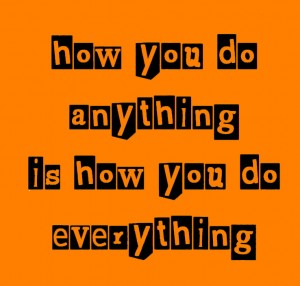
“how you do anything is how you do everything”
When, years ago, I was intensely involved in the development of self and my skills in learning to be a coach, I heard this phrase and it deeply resonated with me and still does.
I’ve already written around this phrase more than once on this site, so today I’ll reflect on this and then link to a phrase that Alan Moore used recently:
Signifier of Intent
Today, then, three parts to this article
- How you do anything is how you do everything – observing others
- How you do anything is how you do everything – awareness of ourselves
- Signifier of Intent – what our current actions indicate about our future path
Observing Others
“how you do anything is how you do everything”
In my first post around this was short and sweet. “How you do anything…a Leaders angle“, I wrote a word of caution:
“If you are in a position of influence or authority, you will find that people are respectful towards you the great majority of the time, but is this a true assessment of their character?
if you have any doubt at all, look to spend time with those people in environments where you can assess how they behave when they aren’t making a conscious effort to impress you.”
“as a way to observe this in yourself and others, watch how people treat those who they feel don’t matter to them.
When you are in busy public places? do they act in a considerate way to others or just push past in a single-minded fashion? In a restaurant, how do they treat the staff? Do they thank the bus driver when they get off the bus? In general, are they present, observant to other human beings, no matter their station or status?”
Awareness of Ourselves
Months after that post on observing others, I moved onto our own actions as leaders with “What do your actions say about your Leadership?“:
“If you are a leader, it is one thing to talk about vision, values and culture, but do you ensure that the way the entire organisation operates is in line with that?
I’m sure your gut response is “yes, of course!”, but in decades in business and over a decade supporting brave leaders, nothing in life is absolute, and it is in the moments of truth, small and large, that we demonstrate our leadership.
Even when it hurts our commercial results, even when we put our own job or ourselves at risk. Fire that client, make a decision that reduces your profit margin, stand up for what you stand for, what your organisation stands for.
As I wrote in “We can all be brave leaders through our individual actions“:
“All we need do is simply take a stand for what we believe in, by simply being of integrity to that and acting from that place. Leaders who do not, lose their followers.””
Signifier of Intent
So, we’ve first looked at observing others in how they treat others as an indicator from “how you do anything is how you do everything”.
We then moved onto the choices and actions of leaders and what they indicate about what we stand for, our values and beliefs.
For today’s extension of that thought, I give you Alan Moore’s phrase:
Signifier of Intent
Alan coined this phrase during our foundational two-day retreat in November that marked the starting point of building a community around the concept of Beautiful Leadership, as I’ve written about multiple times here before and since (see search results on that term here).
Now, there is a phrase called “virtue signalling”, which in the theoretical sense is about conspicuous and conscious of expression of values of an organisation or individual. However, in the last few years, with the rise of social media, it has tended to become a pejorative term, focussed on more “empty” uses of signalling such as updating a Facebook profile to support a movement or idea yet without any more concrete action.
So what did Alan’s term mean to me?
To me, a “Signifier of Intent” links closely to “how you do anything is how you do everything”. Such language feels solid, substantive, material, it shows action and commitment in a meaningful way.
In the case of Beautiful Leadership and what Alan and I are looking to catalyse, it begins with the energy, passion and time commitment of those getting involved at these early stages. At another level, we are already looking to bring in major corporate partners who believe in business as a force for good and that they, believing in the idea and power of Beautiful Leadership, will invest material amounts to “Seed” the development of programmes and other work that will propagate Beautiful Leadership at many different levels and ensure maximum accessibility (as befits leading beautifully!).
I give you today one example of a leader signifying intent in such a solid and material way, with Sacha Romanovitch. In the article link (click on her name), she responded to the issue of income inequality and the radically growing gulf between the pay of the average worker and CEO pay. How? She simply capped her own pay as CEO to a multiple of average pay in her firm. She also made the radical step of changing her firm from one where all the profits went to the partners to become a shared enterprise where all staff benefitted. She simply strongly believed in the good of these moves for all and for society so signified her intent.
